Analysis and Commentary of Bach's Prelude and Fugue in C# Major WTC II BWV 872
Prelude
A prelude is a piece of music that leads into a fugue and generally has more of an improvisational quality when compared to the strict contrapuntal rules of the fugue. Bach in his lifetime wrote two sets of twenty-four prelude and fugues in every key, them being a collection of The Well-Tempered Clavier (Das Wohltemperirte Clavier). In this paper, we will explore the third from the second book of WTC.
There are multiple sources of the prelude. The earliest version – written in C major where the first half (M 1–24) is written in plain chords in minims – is from a copy made by Anna Magdalena Bach probably around 1738. Bach then wrote a draft copy, realizing the chords in an elaborate arpeggiation pattern. Eventually, Bach added various improvements to the tenor line of the chordal pattern, which is what Altnickol used for his 1744 copy, which scholars today believe that “there is no doubt that this version represents Bach’s final and best thoughts” (Ledbetter).
The prelude begins with the bass and tenor voice, immediately followed by the soprano line that holds the last note with a tied quarter note with the alto line providing continuous motion of the sixteenth notes.

The notes that are not a part of the chord is circled. From this, we can see that the last note of the alto line in each motif typically resolve to the chord tones. Due to this, we can see that a novelty occurs from the third beat of the second major to the first half of the third measure. This is quite similar to the C major prelude from WTC I, with not only the arpeggiation but also the tensions and release.
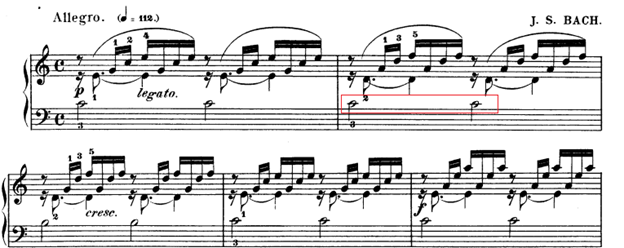
In the second measure of the C major prelude, we can see that the C becomes a pedal point. This is not so aurally obvious without deliberately distinguishing the alto (also more commonly written as tenor) voice from the bass voice. However, unlike the C Prelude, the C# Prelude adds more complexity to the dissonant suspension by adding lingering notes from the previous measure, essentially creating a suspension leading to another suspension before finally resolving back to the I chord.
At a somewhat larger scale, the prelude can be divided into periods. If measures 1-6 could be considered the first period that ends in the dominant, then measures 7-20 can be considered the second half that finally returns to the tonic. The end of each period is characterized by the passing tones that return to the starting note in the tenor voice, which only appear twice and only at the end of large statements, which will be marked in red in the image below.
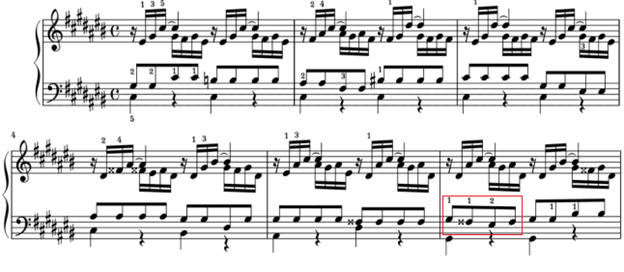
Also note the dissonant suspension in the upper voices, delaying the consonant resolution to create a constant moving motion.
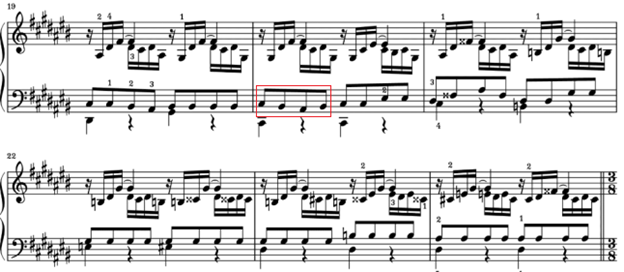
Measures 20–25 consists of short modulatory passage that ends on the dominant, leading to the fugato in 3/8.
Fugato
The fugato, unlike the prelude, consists of only three voices. Preceding the fugue however, it gives a bit of a spoiler of the fugue as it contains many of the same elements, including the use of stretto, which is liberally used in the fugue.
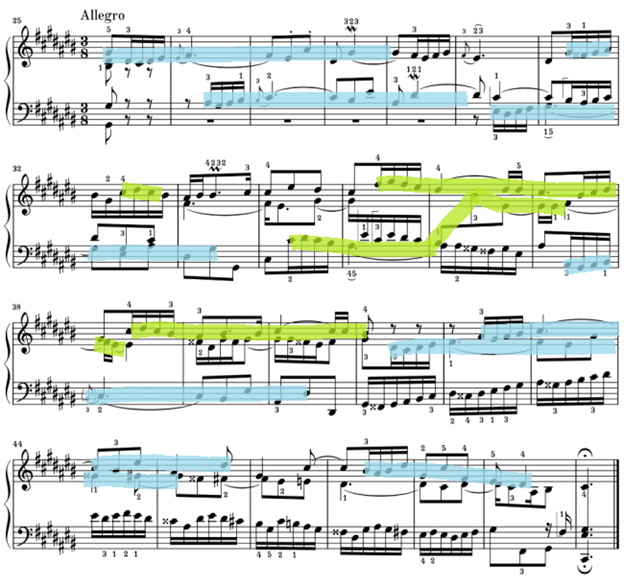
The subject is highlighted in blue, while its inverted form is highlighted in lime. This fugato seems to lack a clear countersubject, or if it does, the intervallic values are not consistent. However, due to the small size of the fugato, not much is missed due to the absence of one.
Fugue
The fugue strays from orthodox fugue development with the usage of stretto. Due to this, many players may find the subject of the fugue unclear, with some believing it to be the first four notes, the first five, or the first bar and a half.

The above is the first three measures. The subject is highlighted in blue while its inversion is highlighted in lime. The freer fragments of the subject is highlighted in purple.
Normally, a fugue introduces its voices after the completion of the subject. In a traditional three-voice fugue, the form of the introduction of the voices is as follows:
| First Voice (Bass) | Second Voice | Third Voice |
|---|---|---|
| Subject | ||
| Countersubject | Answer | |
| Free | Countersubject | Subject |
If we consider the traditional expository form and superimpose it onto this C# fugue, then it makes sense for the subject to be an unusually short four notes. However, we can visually and aurally experience three measures in stretto because of their intervallic and harmonic relationship.

As the fugue continues, Bach introduces the diminution of the subject here, which seems to consist of either four or five notes. If considered in the perspective of the subject being a bar and a half, this can be interpreted as subject heads being played instead of the entire subject, akin to a false start. From this, it may be reasonable to assume that Bach cared less about the “rules” of fugue than the aesthetic of components building upon each other to create a whole. Note that in measure 4, the bass voice can be considered a tonal answer, and as such, it is highlighted in green. The only unhighlighted portion in measure six may potentially be considered a miniature episode before introducing the countersubject (or another depending on one's interpretation on the subject).
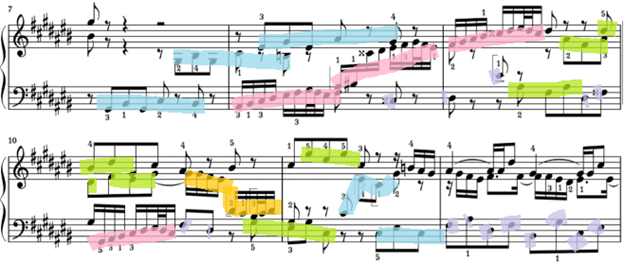
The countersubject is introduced in pink while the inversion of the countersubject is highlighted in orange. The episode follows the countersubject at the end of measure 11 to beat 3 on measure 14. The same motif consisting of a dotted note followed by a sixteenth is employed in this episode as well, reinforcing that the previous miniature episode was indeed such. The notes highlighted in purple once again reinforce the aesthetic of the fugue by incorporating pre-existing rhythmic elements from the main subject, creating a coherent picture for the entirety.
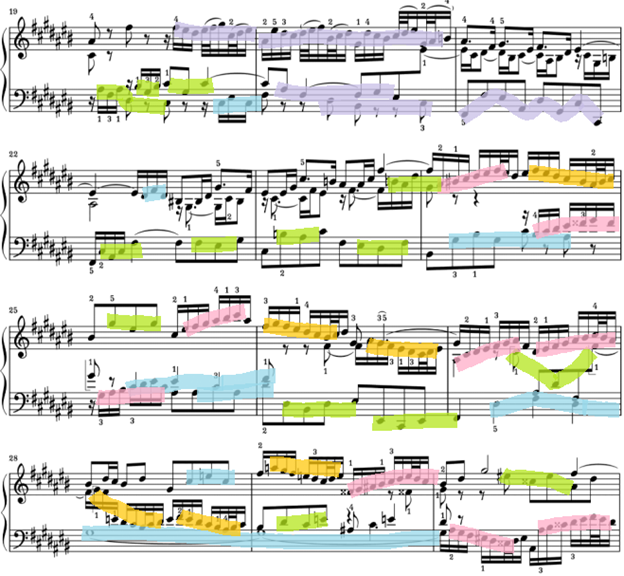
We can see that whenever there is the dotted eight and sixteenth motif, there is always a musical transition to a subject. Furthermore, we can see a new contrapuntal device in the form of augmentation in measures 25 and 27-29. The strong and heavy augmentation seems to support the idea of a four note subject, as it would seem odd to have a motivic false start here.
From measure 30, the fugue recapitulates, with the number of individual lines increasing to five, specifically in measure 32.
The C# Prelude and Fugue from the second book may not be the most orthodox, but the symphony of lines nonetheless create a moving and beautiful harmony as Bach places great focus and interest on musical aesthetics.